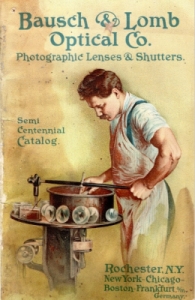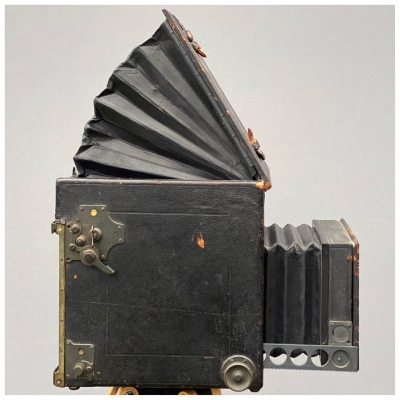

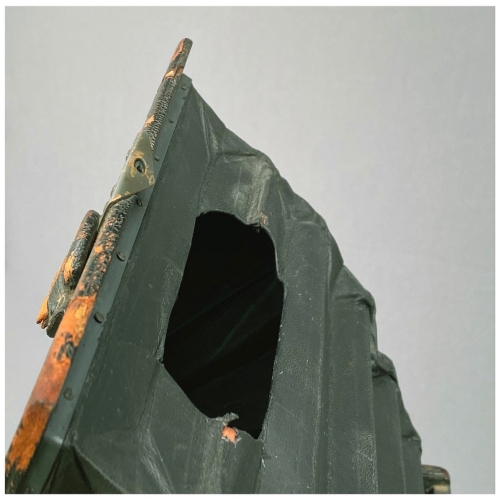
The Auto Graflex
The huge
5 x 7 inch Reflex Press camera
1906



Sizes when closed : 24 cm high, 23 cm long and 21cm wide !
Missing cover brackets and missing strap handle, leather camera cover in
very bad
shape and a not functional stiff focal plane shutter.
The accordion style viewing hood has had its best days long time ago but still
usable. This was the condition of this interesting designed Graflex Camera
named
AUTO GRAFLEX
The Folmer and Swing Company in Rochester advertised the Auto
Graflex as a reflex camera for street and press purposes.
The advertisement emphasises the advantage of the - front hinged - accordion viewing hood which
enables the photographer to see the image on the ground glass
in full size and right up at the very instant of exposure.
The advertisement shows the hunter on his head and the message is:
"If you had to stand on your head to shoot you wouldn't bring home much game"
The Auto Graflex typical accordion viewing hood with the peep slit emphasises
the importance of the reflex camera
to prevent the above mentioned negative effect.
The slit in the accordion viewing hood was continued until 1910 as from then on
this typical hood was replaced by the rear hinged
folding chimney hood,
The Accordion Hood
The first edition Auto Graflex cameras was equipped with the
accordion front hinged viewing hood, matching brackets and button release.
The camera on the photos (before restoration ) is
the largest of three formats.
Film format 5x7 = Lens board size 4x4 inch.
The very impressive accordion viewing hood, provided with a bit shabby looking
excision oval slit serving as a peephole, prevents incoming stray light to fall on the ground glass.
Looking down through the slit onto the ground glass the photographer could see
the image right up.
To realise focussing without bending ones head down to the ground glass, the
photographer could also look straight ahead to focus on a mirror mounted opposite
the eye level.
This mirror is placed in an angle of 45 degree and thus making it possible to
reflect the ground glass' image.
This construction allows the photographer to look straight forward into the
cut out peep hole and
still see the focusing target on the ground glass, albeit on its head
*
Indeed another advantage of this remarkable viewing hood especially for
street or press photographing.
The accordion Auto Graflex with the front hinged cover was made from
1906 till 1910 in the film sizes 4x5 and 5x7"
The next badge produced as from 1916 was equipped with the "normal" straight folding rear hinged
"chimney" viewing
hood.
A remarkable detail is the front lens cover. It exist out of a kind of box with
on the inside the easy to change lens board with lens and on the outside a
hinged door.
The inside of the box is covered with leather as well is the inside of the
hinged door.
I don't have the slightest idea about the purpose of this box
construction. A smaller metal hinged door in the middle of the bigger front door,
pops open when the lens is turned outwards.
*) In this situation the advantage of the reflex camera mentioned in the
ad (stand on your head), has been unmade. ☺
Repair
Manufacturing cover brackets.
Although it would be a great coincident if you would find a
camera like mine which misses the cover brackets, I cannot hide my proud
to let you know how I manufactured these odd shaped brackets out of steel.
The camera top cover came without the leather strap handle and missed both top cover brackets to hold the
cover with the accordion viewing hood upright.
Furthermore the focal plane shutter was extremely dry and brittle and non
functional. Even the lens including lens board was missing.
Nevertheless I decided to accept the
challenge to start the restoration. First of all I tackled the focal
plane shutter, renewed the fabric but used the old clips.
I followed the same procedure as I did before by
renewing the Graflex Home Portrait camera.
Not being a metalworker I had to find a way to make these top cover
brackets and started with thin cardboard test designs to see how this would act
while opening and closing the top cover.
Once I found the right shape, I
cut them out of 0,3 mm copper plate which is very easy to cut and bend.
To get these cover brackets working I also had to find admittance to the bellows
storage in the front of the camera.
This proved to be difficult as the screws
-holding the back frame of the bellows- were difficult to find under the folded
plies of the bellows.
You'd need a thin long screwdriver and and a third hand to
hold the torch.
Carefully tear the bellows strait up. Now you can discover 4 screws on each side
of the bellows connecting the rear bellows frame to the rear front of the lens
standard.
A tall screwdriver helps you to turn the screws loose. Don't loose your patience.
When all screws are loose you may lift the bellows out of the case.
The first two pictures show the removal of the bellows giving
entrance to the bellows storage space.
the third photo shows one of the screws in the narrow space between camera and
bellows.
Make sure to get the right screwdriver!
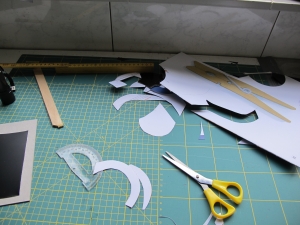
Using thin cardboard as a kind of a dummy for testing purposes.
Finding the right bow shape of the sliding bracket that makes it possible to
open and set the cover
and the viewing hood upright for focusing.
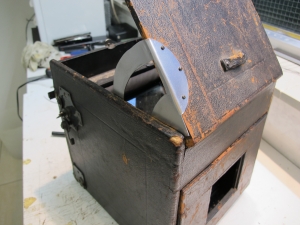
This is how it looks.
A poor "try out cut" made out of bras and finally the provisional steel
bracket result
which proves to be good working.
The last photo shows the bellows storage in which the end of the bracket will
find its place when the cover has been closed.
Realising that the old leather was definitively unsuitable to be restored,
I decided to undress the camera to see how it looks then.
I might find some new leather to cover the camera with, but up till now I like
the wooden appearance as it is. Maybe some varnish would give it a nicer and warmer look.
Further more I managed to make a new strap holder. A very nice brass
Bausch & Lomb Series IIb 5x7 lens fitted in a home made wooden lens holder
completes the outer performance.
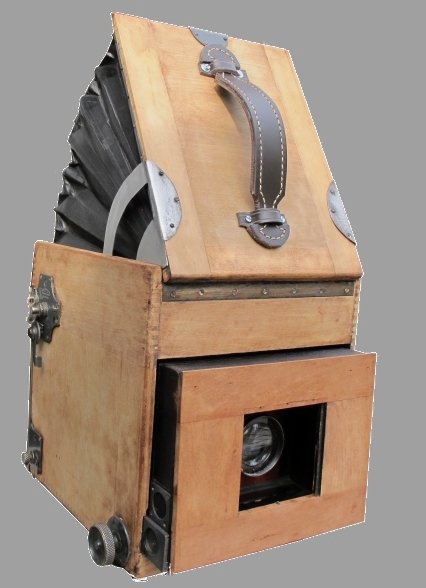
My next project:
The 3¼ x 4¼ Auto Graflex
The refurbishment of an attic found.
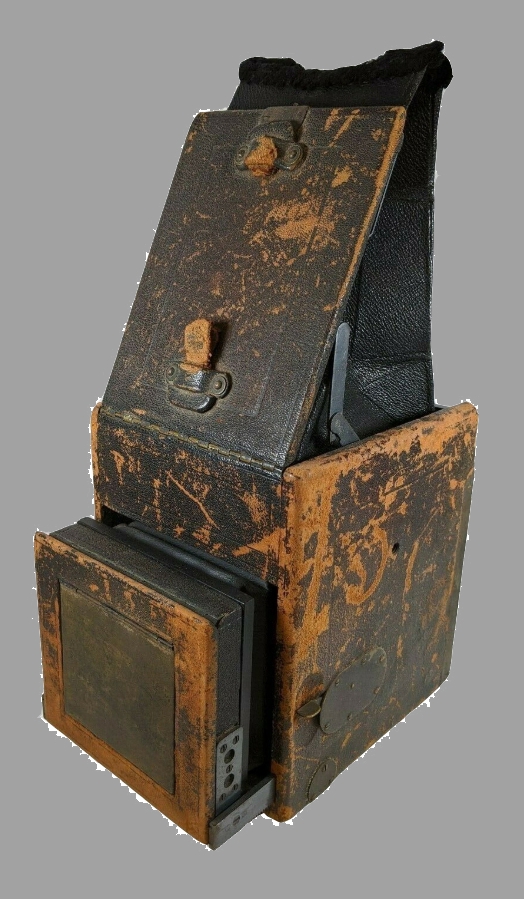
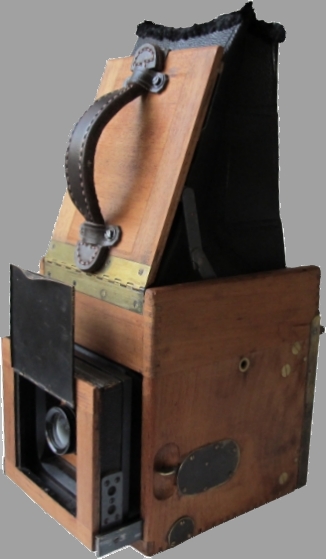
Unlike its older and bigger brother, this 3 ¼ x
4 ¼ successor
Auto Graflex was equipped with the strait up viewing hood with fur top rather
than the
accordion hood with the peep hole.
However both cameras had the same front hinged door and a very odd front lens
housing.
Further detail, the first Auto Graflex edition had a button release knob which had been replaced by a release handle
in this second edition. Both cameras were equiped with an enclosed lens standard
with hinged door which opened automatically when the lens was turned out in
focusing position. Even the inside of the front lens enclosure was strangely enough
covered with leather.
My purchase showed a very poor appear due to the extremely worn leather,
probably due to moisture.
A closer look ad the eBay photos learned me that none of the visible screws
showed any signs of repair which gave me the right feeling to buy it.
Once the camera arrived, my hope came true and obviously the camera was never
taken apart for repair and there was no damage beside the brittle fabric of the
focal plane shutter.
This camera type with the front hinged folding hood was manufactured from1911 to
1915 and one can be pretty sure that the focal plane shutter rubberised
fabric
will be completely stiff after being kept packed over one hundred years. Also very
often the carrying strap handle of these cameras is broken and the one of my new purchase, was no
exception.
Apart from the stiff and brittle focal plane shutter, the broken strap handle and
the missing lens, the camera was
technical perfect okay, but needed care and for all a complete technical
overhauling. Cosmetically however it was a
disaster and my intention was to remove the old worn leatherette and to replace it by
new leather or to undress it and keep it in its uncovered wooden natural outfit.
I ordered new cloth for the focal pane shutter. Meanwhile waiting for the
delivery I removed very carefully the clips out of the old curtain and if
necessary
bent them into the right shape. This is easier said than done. The making
of a
new focal plane shutter is quite a job and it takes time, skills, feeling and
for all patience.
The reward is a perfect working one hundred year old classic camera.
Undressing the wooden body from its leather
cover and removing the
shutter mechanics.
I found an old worn and for all stiff and brittle focal plane shutter inside the camera.
On the right the
old shutter curtain next to the new uncut fabric.
After cutting the slits and mounting the old clips into the new
fabric,
the rebuild focal plane shutter is ready to get installed into the camera.
The ugly duckling after the metamorphose has become a handsome wooden classic camera but still
misses a carrying hand-strap.
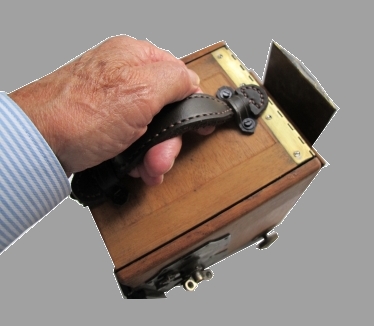
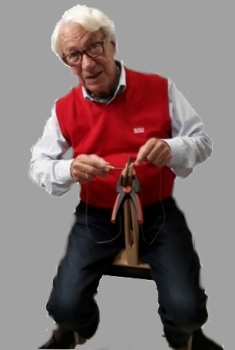

One of the collectors worst nightmare would be picking up an old precious camera
by its strap handle which turns out to be too brittle to hold the heavy camera
which definitely ends up with a broken camera laying on the floor.
Most of these classics are more than a century old and one of the cosmetic shortcoming is the leather strap-handle. Next to the leather loops connected to
the camera top, the strap is brittle and will definitely break when tilting the
camera. Two new brackets and a new proper leather handle would be more than
necessary in order to get a nice display and even more important to safely take the camera out.
Stitching such a close to original strap holder is quite a job but also a gratifying activity.
By the way, now all this has been done, I wonder if I ever will cover this good looking camera with black
leather again to bring it back into its original shape.
To be frank, I don't think I will. It just looks so nice as it is now.
In the mean while I was very lucky to find a nice B&L lens to complete the refurbishment.
Are you looking for a new original personalised strap holder?
I would be pleased to make one for you.
More info
